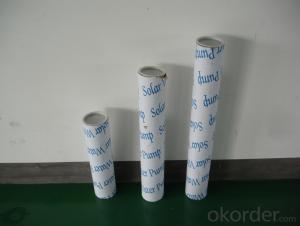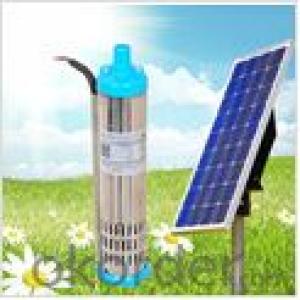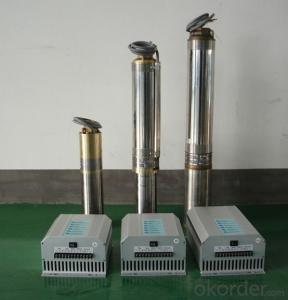Shakti Solar DC Solar Submersible Pumps
- Loading Port:
- China Main Port
- Payment Terms:
- TT OR LC
- Min Order Qty:
- -
- Supply Capability:
- -
OKorder Service Pledge
OKorder Financial Service
You Might Also Like
Item Description :
This superb new addition to our solar fountain range comes with a 10w solar panel,and a powerful fountain pump that is capable of producing fountains of up to 2m in height. As well as being easy to set up and use.Instruction manual is supplied for assembly and maintenance.
Solar Fountain Key Features :
Powered by direct sunlight
No high voltage electric mains required
Safe for children
Max. height of fountain: 2M
Max. flow capacity: 800 L/H(176 GAL)
10W Polycrystalline solar panel included
18V DC brushless pump
Solar Pump Features :
Can produce fountains up to : 2M (tube height) 1.4M (fountain height)
Comes with multiple nozzle accessories
Cable Length : 5M
Solar Panel Features :
10W peak power.
Polycrystalline highly efficient solar panel
Comes mounted in aluminium frame
Comes with ground stake and rotating knob so you can angle your panel toward the sun
What You Will Get :
10W solar panel
Solar pump
Ground Sake
Nozzle accessories
Precautions :
DO NOT alter or change the product itself or its components
Operate pump in freshwater only, never above 50 degrees celsius
Keep away from flammable liquids
Do not connect to any other power supply other than the included
- Q: Can a solar pump be used in developing countries?
- Yes, a solar pump can be used in developing countries. Solar pumps are a suitable solution for areas where electricity access is limited or unreliable. They provide a sustainable and cost-effective option for water supply, irrigation, and other agricultural activities in remote and off-grid locations. The use of solar pumps can help improve access to clean water and support socio-economic development in these countries.
- Q: How much sunlight is needed to operate a solar pump effectively?
- The amount of sunlight needed to operate a solar pump effectively depends on various factors such as the size and efficiency of the solar panels, the power requirements of the pump, and the geographical location. In general, solar pumps require a certain level of sunlight to generate enough energy to power the pump and meet its operational needs. Most solar pumps are designed to work optimally with direct sunlight, which means that the panels should be exposed to the sun's rays at a 90-degree angle. This allows for maximum absorption and conversion of solar energy into electrical power. However, solar pumps can still function to some extent under partial sunlight or diffused light conditions. The efficiency and performance of the pump may be reduced, but it can still operate to a certain degree. The amount of sunlight required also varies depending on the power requirements of the pump. Higher power pumps may require more sunlight to generate enough energy, while smaller pumps may be able to operate effectively with less sunlight. Additionally, the geographical location plays a significant role in determining the amount of sunlight available. Regions with higher solar irradiation, such as those closer to the equator or with less cloud cover, will receive more sunlight and therefore allow solar pumps to operate more effectively. Conversely, areas with lower solar irradiation or frequent cloudy conditions may require larger solar panels or backup energy sources to ensure the pump operates efficiently. In summary, the amount of sunlight needed to operate a solar pump effectively depends on the size and efficiency of the solar panels, the power requirements of the pump, and the geographical location. While direct sunlight is ideal, solar pumps can still function to some extent under partial sunlight or diffused light conditions. It is important to consider these factors when determining the suitability of a solar pump for a specific application or location.
- Q: How does a solar pump handle water source contamination from sewage leaks?
- A solar pump operates independently of water source contamination from sewage leaks as it draws water directly from a natural source like a well, river, or pond. It does not come into contact with the contaminated water, ensuring the safety and purity of the pumped water.
- Q: Are there any safety measures or precautions to consider when using a solar pump?
- Yes, there are several safety measures and precautions to consider when using a solar pump: 1. Electrical Safety: Solar pumps may generate electricity, so it's important to follow electrical safety guidelines. Ensure that all wiring and connections are properly insulated and protected from water or physical damage. Use a circuit breaker or disconnect switch to shut off power when performing maintenance or repairs. 2. Water Safety: When working with a solar pump that draws water from a well or pond, be cautious of potential water contamination. Use a suitable filtration system to remove impurities and regularly clean and disinfect the water source. Additionally, ensure that the pump is properly sealed to prevent water from entering critical components. 3. Overheating Prevention: Solar pumps rely on sunlight to generate power, and excessive heat can reduce their efficiency or damage components. Install the pump in a shady area or use a protective cover to shield it from direct sunlight, especially during peak hours. Regularly check for any signs of overheating, such as melted wires or burnt smells. 4. Maintenance and Inspection: Regular maintenance and inspections are crucial to ensure the safe and efficient operation of a solar pump. Follow the manufacturer's guidelines for routine checks, cleaning, and lubrication. Inspect the pump's components, such as panels, wiring, and valves, for any signs of wear or damage. Promptly address any issues to prevent further complications. 5. Installation and Mounting: When installing a solar pump, carefully follow the manufacturer's instructions and guidelines. Ensure that the pump is securely mounted to prevent any accidental falls or damage. Use appropriate mounting brackets or structures that can withstand the weight and environmental conditions. 6. Training and Education: It is essential to have adequate knowledge and training on the operation of solar pumps. Understand the pump's specific features, controls, and safety precautions. If necessary, seek professional assistance or training to ensure safe and effective use. By following these safety measures and precautions, users can minimize the risk of accidents, optimize the performance of their solar pump, and ensure its longevity.
- Q: Is it possible to use a solar pump in areas with high water tables?
- Yes, it is possible to use a solar pump in areas with high water tables. Solar pumps are designed to draw water from underground sources such as wells, boreholes, or even directly from high water tables. The efficiency and effectiveness of the solar pump may vary depending on the specific conditions and the size and capacity of the pump, but in general, solar pumps can be successfully used in areas with high water tables to provide a cost-effective and sustainable solution for water pumping needs.
- Q: How does the presence of shading affect the performance of a solar pump system?
- The presence of shading can have a significant impact on the performance of a solar pump system. Shading can occur due to nearby buildings, trees, or other obstructions that block sunlight from reaching the solar panels. When shading occurs, the amount of sunlight that can be captured by the solar panels is reduced, resulting in a decrease in the amount of energy produced. This reduction in energy can directly affect the performance of the solar pump system as it relies on solar energy to operate. Shading can lead to a decrease in the pump's efficiency, causing it to work at a lower capacity or even stop functioning altogether. The reduced energy input can result in slower water flow rates, decreased pumping heights, and overall reduced performance. Furthermore, shading can also lead to an imbalance in the solar panel array. When only a part of the panel is shaded, it may cause a significant drop in voltage and current output. This can result in the system's inverter shutting down or triggering an automatic protective mechanism to prevent damage. To mitigate the negative effects of shading, various measures can be implemented. One option is to optimize the system's design and placement to minimize shading. This may involve selecting an appropriate location for the solar panels, ensuring they are positioned to receive maximum sunlight throughout the day. Another approach is to use advanced technologies, such as micro-inverters or power optimizers, that can mitigate the impact of shading on the overall system performance. These devices can help to regulate the voltage and current output from individual solar panels, allowing the system to operate more efficiently even in shaded conditions. Regular maintenance and cleaning of the solar panels can also help to ensure optimal performance by removing any dirt or debris that may further reduce the energy output. In conclusion, the presence of shading can significantly affect the performance of a solar pump system by reducing the amount of sunlight reaching the solar panels. This reduction in energy input can lead to decreased efficiency, slower water flow rates, and overall reduced performance. However, with appropriate design, placement, and the use of advanced technologies, the negative effects of shading can be mitigated, allowing the system to operate more efficiently.
- Q: How does the cost of a solar pump compare to a windmill or hand pump?
- The cost of a solar pump can vary depending on the specific model and capacity. Generally speaking, it tends to be more expensive compared to a windmill or hand pump. A solar pump is composed of solar panels, a motor, and other components, all of which contribute to its higher price. However, it is crucial to take into account the long-term financial benefits and environmental advantages that come with a solar pump. In contrast, a windmill is typically less costly than a solar pump. Windmills utilize the power of wind to pump water, eliminating the need for electricity. While they may require regular maintenance and entail higher installation costs, their operational expenses are relatively low. Windmills can be a financially viable option in areas where consistent and strong winds are present. On the other hand, hand pumps are generally the most economical choice in terms of initial investment. These devices are simple and rely on human power to extract water from the ground. Compared to solar pumps or windmills, hand pumps have lower installation and maintenance costs. However, they require physical effort and may not be suitable for large-scale water extraction or areas with high water demand. When comparing these alternatives, it is crucial to consider the specific requirements of the water pumping project. Factors such as the required water volume, resource availability in the location, and a long-term cost-benefit analysis should all be taken into account. Although a solar pump may have a higher upfront cost, it offers the advantage of being environmentally friendly, with no fuel costs or emissions. Moreover, solar pumps can be more dependable and efficient in areas with abundant sunlight and can be operated remotely, reducing the need for constant human intervention.
- Q: Can a solar pump be used for emergency water supply during natural disasters?
- Yes, a solar pump can be used for emergency water supply during natural disasters. Solar pumps are powered by sunlight, making them a reliable and sustainable option for accessing water when traditional power sources may be disrupted. They can be used to pump water from wells, rivers, or other sources, providing a vital water supply during emergencies. Additionally, solar pumps are often portable and easy to set up, making them an efficient solution in disaster-stricken areas where infrastructure may be damaged or nonexistent.
- Q: How much maintenance does a solar pump require?
- Minimal maintenance is typically required for a solar pump. Since it operates on solar energy, there are no expenses for fuel or regular oil changes. It is, however, advisable to routinely examine the system for any dirt or debris that could impact its effectiveness. Cleaning the panels to optimize sunlight exposure is also crucial. Moreover, checking the pump's connections and cables for any harm or loose connections is recommended. In general, a solar pump offers reduced maintenance needs in comparison to conventional pumps, making it an economical and environmentally friendly choice for water pumping.
- Q: How does a solar pump handle water level fluctuations in wells or boreholes?
- A solar pump handles water level fluctuations in wells or boreholes by using sensors and controls to adjust its operation based on the water level. When the water level drops below a certain threshold, the pump slows down or shuts off to prevent dry running and potential damage. Once the water level rises to a safe level, the pump resumes its normal operation. This intelligent system ensures efficient and reliable water pumping while protecting the pump and the well or borehole from harm.
Send your message to us
Shakti Solar DC Solar Submersible Pumps
- Loading Port:
- China Main Port
- Payment Terms:
- TT OR LC
- Min Order Qty:
- -
- Supply Capability:
- -
OKorder Service Pledge
OKorder Financial Service
Similar products
Hot products
Hot Searches
Related keywords
























